|
|
|
Sort Order |
|
|
|
Items / Page
|
|
|
|
|
|
|
| Srl | Item |
| 1 |
ID:
160637
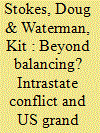

|
|
|
|
|
| Summary/Abstract |
Grand strategic theorists share an historical emphasis on interstate conflict, yet in contrast to the more frequent intrastate conflicts, these represent only 7 of the some 273 US military deployments since 1900. We argue that these intrastate conflicts limit the utility of regional balances of power in mitigating forms of conflict that the US may consider inimical to its national security interests. When considering potential changes to US force posture and grand strategy, American coercive statecraft should be theorised along a broader strategic continuum encompassing the full range of conflict.
|
|
|
|
|
|
|
|
|
|
|
|
|
|
|
|
| 2 |
ID:
123019
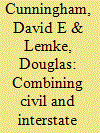

|
|
|
|
|
| Publication |
2013.
|
| Summary/Abstract |
Quantitative studies of conflict analyze either civil or interstate war. While there may be observable differences between civil and interstate wars, theories of conflict focus on phenomena-such as information asymmetries, commitment problems, and issue divisibility-that should explain both conflicts within and between states. In analyses of conflict onset, duration, and outcome combining civil and interstate wars, we find most variables have similar effects on both "types" of war. We thus question whether there is any justification for separate study of war types.
|
|
|
|
|
|
|
|
|
|
|
|
|
|
|
|
| 3 |
ID:
132325


|
|
|
|
|
| Publication |
2014.
|
| Summary/Abstract |
This article examines compliance with international laws prohibiting the intentional targeting of noncombatants in interstate war, specifically focusing on the role of third-party states in enforcement. We argue that the expectation of third-party coercion, when sufficiently high, can induce war participants to comply with this body of law. We identify the conditions under which combatant states will anticipate a high likelihood of coercion, demonstrating that third-party states are most likely to coerce combatants when they have both the willingness and opportunity to do so. Democratic third parties that value the rule of law and human rights possess the willingness to coerce war participants, while strong allies, trade partners, and intergovernmental organization (IGO) partners with existing ties to the combatant state have the opportunity to engage in coercion by linking combat-ant behavior to the provision of benefits or imposition of costs. Based on this logic, we hypothesize that war combatants who have ratified the Geneva/Hague Conventions prohibiting the intentional targeting of noncombatants during war are more likely to comply with the legal obligations included in those conventions when they interact with relatively strong democratic alliance, trade, and IGO partners. In a series of quantitative tests on a data set of all interstate wars from 1900 to 2003, we find strong statistical and substantive support for the role of third parties in inducing compliance with the law.
|
|
|
|
|
|
|
|
|
|
|
|
|
|
|
|
| 4 |
ID:
189012
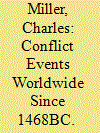

|
|
|
|
|
| Summary/Abstract |
Quantitative datasets of international conflict skew temporally to modern times and geographically and culturally to the West. Yet post–1815 conflicts featuring Western actors are only a small part of the history of warfare. Many scholars have bemoaned the potential selection bias which this introduces to studies of the causes and effects of military conflict, but as yet quantitative datasets which remedy both these temporal and geographic shortcomings have been lacking. Some datasets have expanded the scope of existing offerings temporally and others spatially, while others have attempted to expand both but with an important lack of detail in terms of location, participants, timing and outcomes. This dataset sets out to remedy the deficit. Using military history’s most extensive encyclopedia of conflict events, we have created a dataset of conflict events spanning the globe and a timescale from 1468BC to the invasion of Iraq in 2003, complete with precise geographic coordinates, year, participants and outcome. We demonstrate the promise of this data-set by using it to assess the frequently asserted relationship between conflict history and economic development, combined with Nordhaus’ GECON sub–national wealth data and historical data on population density from the Netherlands Environmental Agency.
|
|
|
|
|
|
|
|
|
|
|
|
|
|
|
|
| 5 |
ID:
148793
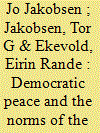

|
|
|
|
|
| Summary/Abstract |
The democratic peace literature has convincingly shown that democracies do not fight other democracies. Theoretical explanations of this empirical phenomenon often claim that the citizenry in democracies prefers peaceful resolution of interstate conflicts. Still, there is a dearth of studies exploring the public’s preferences and values directly. We seek to rectify this by investigating, in a novel way, the relationship between regime type and citizens’ bellicosity. A comprehensive multilevel research design is employed, with data spanning 72 countries over the period of 1981–2008. This enables us to test one of the theoretical mainstays of the democratic peace thesis, viz., that regime type helps shape individuals’ attitudes toward war-fighting. Our results lend special support to normative democratic peace theory: Citizens of democracies are significantly more pacifistic than citizens of non-democracies. This result upholds when we rigorously control for other relevant factors, including specific characteristics of individuals and rival theoretical explanations.
|
|
|
|
|
|
|
|
|
|
|
|
|
|
|
|
| 6 |
ID:
112468
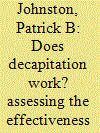

|
|
|
|
|
| Publication |
2012.
|
| Summary/Abstract |
Is killing or capturing insurgent leaders an effective tactic? Previous research on interstate war and counterterrorism has suggested that targeting enemy leaders does not work. Most studies of the efficacy of leadership decapitation, however, have relied on unsystematic evidence and poor research design. An analysis based on fresh evidence and a new research design indicates the opposite relationship and yields four key findings. First, campaigns are more likely to end quickly when counterinsurgents successfully target enemy leaders. Second, counterinsurgents who capture or kill insurgent leaders are significantly more likely to defeat insurgencies than those who fail to capture or kill such leaders. Third, the intensity of a conflict is likelier to decrease following the successful removal of an enemy leader than it is after a failed attempt. Fourth, insurgent attacks are more likely to decrease after successful leadership decapitations than after failed attempts. Additional analysis suggests that these findings are attributable to successful leadership decapitation, and that the relationship between decapitation and campaign success holds across different types of insurgencies.
|
|
|
|
|
|
|
|
|
|
|
|
|
|
|
|
| 7 |
ID:
153888


|
|
|
|
|
| Summary/Abstract |
This article examines the potential use of autonomous aerial weapons for targeted killing purposes and, in doing so, looks beyond the now-familiar “global war on terror.” We argue that the combination of novel capabilities with the pre-existing military-theoretical frameworks of advanced Western states, within which autonomous weapons will be embedded, may be conducive to an expansion of targeted killings to scenarios other than military counter-terrorism. The confluence of autonomous weapons and targeted killing practices may therefore lead to a further weakening of long-standing norms regulating the use of force, including in interstate scenarios. We also find that international regulation is unlikely to forestall this outcome, and that political-military insistence on centralized operational control may mitigate—but not negate—the disruptive potential of these developments. As a result, the possible consequences for the international order of an evolution of targeted killing practices along these lines should not be underestimated.
|
|
|
|
|
|
|
|
|
|
|
|
|
|
|
|
| 8 |
ID:
178530
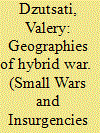

|
|
|
|
|
| Summary/Abstract |
What explains the variation in violence in the internationalized civil conflict? This study identifies such conflict as an adaptation of insurgency warfare by the state. The analysis of the conflict in Eastern Ukraine indicates that violence levels peak in the areas where the preexisting political loyalties for the challenger state were strongest, where the central government of the incumbent state has inadequate access, and where the impact of war on civilians is relatively low. The study also points to the importance of scaling factors for determining the intensity of violence.
|
|
|
|
|
|
|
|
|
|
|
|
|
|
|
|
| 9 |
ID:
096696
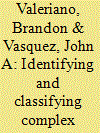

|
|
|
|
|
| Publication |
2010.
|
| Summary/Abstract |
This article takes a closer look at multiparty wars in the modern state system. Because wars are different, a classification system of interstate wars is useful for theoretical concerns and empirical testing. We label multiparty wars "complex" because we believe that the processes that bring them about are much more complicated and difficult to understand than dyadic wars. Complex wars are identified and classified on the basis of their size, the issue that gives rise to them, and whether they are preceded by certain behavioral processes. To see if the classification is empirically useful, a set of empirical expectations on which wars should differ is derived and employed to conduct a series of tests. It is found that dyadic wars are associated with different patterns from complex wars, and that within the set of complex wars, the larger wars differ from the smaller ones on several dimensions. It is also found that larger wars and wars over certain issues are likely to be preceded by different behavioral processes, especially in terms of the use of power politics practices. The classification breaks down each complex war into its component dyadic participants on a number of variables so that one can compare originating dyads with each joiner dyad to show how wars differ according to type.
|
|
|
|
|
|
|
|
|
|
|
|
|
|
|
|
| 10 |
ID:
178686
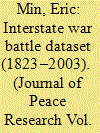

|
|
|
|
|
| Summary/Abstract |
Extant scholarship on interstate war and conflict resolution predominantly utilizes formal models, case studies, and statistical models with wars as the unit of analysis to assess the impact of battlefield activity on war duration and termination. As such, longstanding views of war have not been tested systematically using intraconflict measures, and deeper studies of war dynamics have also been hampered. I address these gaps by creating and introducing the Interstate War Battle (IWB) dataset, which captures the outcomes and dates of 1,708 battles across 97 interstate wars since 1823. This article describes the sources used to create these data, provides definitions, and presents descriptive statistics for the basic battle data and several daily-level measures constructed from them. I then use the data to test the implications of two major theoretical perspectives on conflict termination: the informational view, which emphasizes convergence in beliefs through battlefield activity; and Zartman’s ripeness theory, which highlights costly stalemates in fighting. I find suggestive evidence for informational views and little support for ripeness theory: new battlefield outcomes promote negotiated settlements, while battlefield stagnation undermines them. The IWB dataset has significant implications, highlights future research topics, and motivates a renewed research agenda on the empirical study of conflict.
|
|
|
|
|
|
|
|
|
|
|
|
|
|
|
|
| 11 |
ID:
138306


|
|
|
|
|
| Summary/Abstract |
How and why do regime type and interstate war affect government spending? We argue that a political leader allocates scarce resources between social and military expenditures as a function of their relative efficiency in securing her political survival. We derive four hypotheses concerning how mobilization for and demobilization from interstate war affects government spending differently in democratic and autocratic regimes. Compared to democracies, autocracies should increase military spending to a greater degree during wartime and decrease military spending to a greater extent following a war. Autocracies also should cut social spending more during an interstate war and increase social spending more during the process of demobilization from war than democracies. Our analyses of all states in the international system from 1950 to 2001 yield support for our hypotheses.
|
|
|
|
|
|
|
|
|
|
|
|
|
|
|
|
| 12 |
ID:
147082
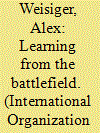

|
|
|
|
|
| Summary/Abstract |
What drives leaders’ decisions about whether to continue or end an ongoing war? The private information explanation for war holds that leaders fight because they believe that doing so will advance national interests, and they settle hostilities when new information reduces their optimism about the possibility of long-term success. Yet significant theoretical disagreement exists about both the extent to which and the manner in which new information, especially battlefield information, promotes settlement. This article unpacks the logic of the informational mechanism, arguing that settlement will be more likely when there has been more extensive fighting and that countries are more likely to make concessions to end wars when battlefield results have deteriorated; short-term spikes in war intensity by contrast do not promote settlement. Moreover, building on work on leadership turnover and settlement, I show that leader replacement is sometimes part of the information-updating process, especially in autocracies: new leaders without political ties to the person in power at the start of the war are more likely both to come to power when war is going poorly and to end wars once in office. Tests of these arguments make use of new participant-level data on the timing of battle deaths for all Correlates of War interstate wars, which allows me to examine the effects of changing battlefield developments across a wide range of cases in a manner that was previously impossible.
|
|
|
|
|
|
|
|
|
|
|
|
|
|
|
|
| 13 |
ID:
140172


|
|
|
|
|
| Summary/Abstract |
How do the outcomes of international wars affect domestic social change? In turn, how do changing patterns of social identification and domestic conflict affect a nation’s military capability? We propose a “second image reversed” theory of war that links structural variables, power politics, and the individuals that constitute states. Drawing on experimental results in social psychology, we recapture a lost building block of the classical realist theory of statecraft: the connections between the outcomes of international wars, patterns of social identification and domestic conflict, and the nation’s future war-fighting capability. When interstate war can significantly increase a state’s international status, peace is less likely to prevail in equilibrium because, by winning a war and raising the nation’s status, leaders induce individuals to identify nationally, thereby reducing internal conflict by increasing investments in state capacity. In certain settings, it is only through the anticipated social change that victory can generate that leaders can unify their nation, and the higher anticipated payoffs to national unification makes leaders fight international wars that they would otherwise choose not to fight. We use the case of German unification after the Franco-Prussian war to demonstrate the model’s value-added and illustrate the interaction between social identification, nationalism, state-building, and the power politics of interstate war.
|
|
|
|
|
|
|
|
|
|
|
|
|
|
|
|
| 14 |
ID:
157549


|
|
|
|
|
| Summary/Abstract |
Does a shock to the balance of power cause the advantaged actor to exploit its newfound advantage by initiating conflict? The modeling literature on commitment problems as a source of war makes a central assumption that states know and anticipate power shifts. We relax this assumption such that states must estimate future power shifts by looking at past and present capabilities—both their own and those of their adversaries. We incorporate these estimates, and their attendant uncertainty, into a model of war. We find that commitment problems remain a source of war, but that the existing models overpredict war by ignoring this dynamic. States continuously updating their estimates and accounting for uncertainty promotes peace. It follows that the apparent window of opportunity—in which the power balance becomes suddenly favorable to one side—poses less of a threat to peace than previous theories suggest. This result has applications to nuclear proliferation dynamics and conflict in general. We find empirical support for the model in tests analyzing power shifts and interstate wars.
|
|
|
|
|
|
|
|
|
|
|
|
|
|
|
|
| 15 |
ID:
120291
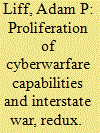

|
|
|
| 16 |
ID:
186095
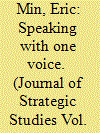

|
|
|
|
|
| Summary/Abstract |
When and why do countries in a wartime coalition engage in diplomacy during hostilities? This paper establishes a theoretical framework of coalitional diplomacy that highlights each member’s private costs and benefits to fighting or seeking a negotiated exit. I argue that the propensity for coalition members to engage in negotiations is a function of the coalition’s balance of military contributions, as well as the coalition’s battlefield successes and failures. Evidence supporting these claims stem from a large-scale quantitative analysis of two centuries of interstate wars, as well as a close study of the Allies in the Crimean War.
|
|
|
|
|
|
|
|
|
|
|
|
|
|
|
|
| 17 |
ID:
182462
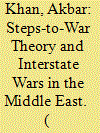

|
|
|
|
|
| Summary/Abstract |
I employ Steps-to-War theory to analyze interstate wars in the Middle East by adding an additional escalating step: state sponsorship of non-state actors. Remarkably, however, the present scholarship completely overlooks a comprehensive assessment of the impacts and roles of state-sponsored terrorism on escalation of interstate militarized conflicts. None of the conflict studies focuses on state-sponsored terrorism and escalation of interstate conflict. This gap still exists despite a remarkable growth in the conflict literature. This article argues that the Steps-to-War thesis is a useful framework for understanding why states end up fighting wars by answering the questions: How does state-sponsored terrorism escalate interstate conflict? And how does each step intertwine with other steps and make war more likely? This paper’s primary argument is that state-sponsored terrorism increases the likelihood of war by providing another escalating step in conjunction with other steps and, therefore, aligns with Steps-to-War theory, and is one of the leading escalating factors. Ultimately, this article argues that this claim has a solid basis, and the Middle Eastern cases vividly demonstrate the escalatory ability of state-sponsored terrorism because state-sponsored terrorism interacts with and reinforces other escalating factors.
|
|
|
|
|
|
|
|
|
|
|
|
|
|
|
|
| 18 |
ID:
075743
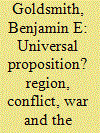

|
|
|
|
|
| Publication |
2006.
|
| Summary/Abstract |
This article assesses the robustness of the liberal or 'Kantian' peace propositions by challenging two common practices: pooling data for different geographic regions, and using conflict at any level as a proxy for interstate war. The findings indicate that there are substantial differences between regions in the effects of democracy, economic interdependence, and international organizations. Conflict (all MIDs) and war have considerably different relationships to these key variables, and to each other, across regions. While I do not argue that these results undermine the general Kantian peace propositions, they do represent powerful qualifications that provide insight into theoretical foundations and raise related questions of specification error. They also point to the continuing importance of concepts such as security communities and norms as liberal factors distinct from the Kantian variables.
|
|
|
|
|
|
|
|
|
|
|
|
|
|
|
|
| 19 |
ID:
120872
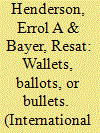

|
|
|
|
|
| Publication |
2013.
|
| Summary/Abstract |
We examine the extent to which wealth, democracy, and/or relative military capabilities contribute to victory in interstate war. Examining contingency tables, we find that states with greater military capabilities are more likely to win their wars whether they are wealthier or democratic, and democratic states perform marginally better than wealthier states in war. Probit analyses indicate that although each of the variables has a robust and positive impact on war victory, relative capabilities has the strongest substantive impact, followed by wealth, then democracy. Hazard analyses reveal that states with greater military capabilities fight shorter wars than either democracies or wealthier states, and controlling for capabilities and wealth, the relationship between democracy and war duration is not significant, which challenges the view that democracies have a unique propensity to fight shorter wars. We also find that the democratic victory phenomenon is not universal, but is contingent on the placement of a single country, Israel, in the Western or non-Western democracy category. In sum, our analyses indicate that although each of the three factors contributes to war victory, relative military capability is the most powerful, consistent, and robust predictor to victory in interstate war.
|
|
|
|
|
|
|
|
|
|
|
|
|
|
|
|
|
|
|
|
|